专题讲座7商务英语语篇翻译
- 格式:ppt
- 大小:2.38 MB
- 文档页数:30
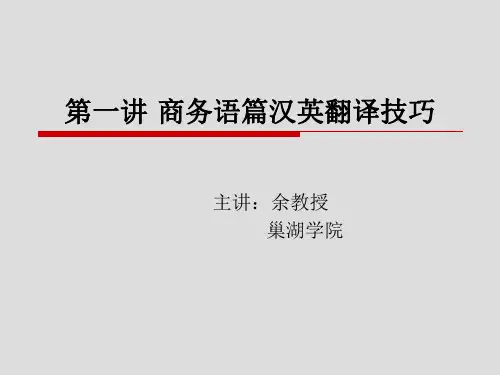

Unit 7 InsuranceRelated InformationThe Basics of Cargo Coverage1. “ALL RISK”coverageThe broadest form of coverage is “ALL RISK”, which, as a misleading name for an insurance policy, provides wide cover but does contain a number of exclusions. The term “All Risks”should not be taken too literally and in some jurisdictions the term is no longer used.An “ALL RISK”policy insures approved general merchandise in the event of physical loss or damage from any external cause. This includes new packaged goods without unusual susceptibility to loss from breakage, pilferage, or the nature of the goods themselves. “ALL RISK”policies do not cover all losses possible in the course of an international shipment.2. General AverageIn order to save a ship in peril of sinking during a storm, some of the cargo may have to be thrown overboard. The ship owner and the owners of the saved cargo obviously benefit at the expense of the owners of the jettisoned cargo. This was deemed unfair and the principle of “General Average” evolved so that all parties would contribute in such a situation.3. (With) Particular Average (WPA)In ocean marine insurance, Particular Average refers to a loss either partial or total, which falls on one or more property or interest being shipped, as opposed to a general average.4. Free of Particular Average (FPA)This is an ocean marine policy provision where coverage is provided only if a total loss of the insured property occurs from an insured peril.FPA (American clause) is limited coverage that usually applies to used merchandise, waste materials and goods shipped subject to an on deck bill of lading. It covers partial and total losses due to FPA perils, which include the sinking, stranding, burning or collision of the vessels or catastrophic perils on shore such as earthquake, derailment, collapse of dock, fire, etc.5. WAR RISKSpecial coverage on cargo in overseas ships against the risk of being confiscated by a government in wartime. It is excluded from standard ocean marine insurance and can be purchased separately.6. Inherent ViceCertain goods are, by their very nature, susceptible to damage and it would beunreasonable to expect insurers to pay for such damage. Examples of Inherent Vice are deterioration of Perishable Goods, spontaneous fermentation or combustion of improperly dried grain.7. WAREHOUSE TO WAREHOUSE protectionMost cargo insurance protects goods in transit from the time they leave the shipper’s warehouse until they reach the consignee’s warehouse, as long as they are not taken out of the normal course of transit by the insured.Lead-in1. Listening1. D2. BTape Script:Tim is talking to Judd about the insurance of a product order.Tim: Good morning, this is Tim. Is that Judd?Judd: Yes, this is Judd speaking.Tim: I’m calling to discuss the insurance coverage you requested for your order.Judd: Good, we requested an amount thirty percent above the invoice value.Tim: We have no problem complying with your request, but we think that the amount is a bit excessive. You know according to our usual practice,we insure the goods only for 10% above the invoice value.Judd: Yeah, but in the past, we’ve really been put in a bind because of damaged goods. Tim: I understand your concern. However, usual coverage for goods of this type is the total invoice amount plus only ten percent.Judd: We could feel more comfortable, though, with thirty percent.Tim: Unfortunately, if you want the increase in coverage, the extra premium will be for your account.Judd: But shouldn’t your quotation include adequate coverage against risks?Tim: That quotation involved normal coverage, but not all. So I suggest you contact your insurance agent there and compare rates.Judd: OK. Thanks. I’ll check it out.2. Spot DictationPart 1 1. T 2. T 3. F 4. F 5.FPart 2 1.practice 2. insurance 3. insure4. the People’s Insurance Company of China5. premium6. covered Tape Script:Sophia: According to our usual practice, we do business with our customers on a CIF basis, Mr. Smith.Smith: That’ s good . It will save us a lot of time because we don’t need to deal with so many insurance formalities. But I’d like to know how much the premium is .Sophia: Well, Mr. Smith, it will vary according to the types of risks to be covered.Smith: I see. Which company do you usually insure with?Sophia: We always insure our goods with the People’s Insurance Company of China. Smith: That’s great. May I ask what insurance you will cover according to your usual CIF terms for these glassware?Sophia: We usually insure against All Risks for glassware.Smith: Including War Risk?Sophia: No, War Risk is a special additional risk and it has to be arranged separately.Generally speaking, it is not necessary to insure against that risk ,as All Risks has provided enough protection to your order.Smith: I see. Thank you for your information.Text ALanguage Study1. insurance①n.the contract made by a company or society, or by the state to provide a guaranteeof compensation for loss, damage, sickness, death, etc in return for regular payment 保险◆People without insurance had to pay for their own repairs.arrange/cover/ effect / provide/ take out + insurance 办理保险◆Under FOB terms, insurance is to be covered by the buyer.insurance company 保险公司insurance policy 保险单insurance certificate 保险凭证insurance premium 保险费insurance value/ amount 保险金额insurance agent 保险代理人②insure vt.make a contract that promises to pay sb an amount of money in case ofaccident, injury death, etc, or damage to or loss of sth 保险,投保◆Every company would insure itself against loss or damage to its property.insurer n.承保人the insured n. 被保险人2. As a large percentage of our foreign trade in and out of this country goes by ship, what mainly concerns us is still the marine Insurance.此句中what mainly concerns us 是主语从句,所以后面的谓语动词用单数。
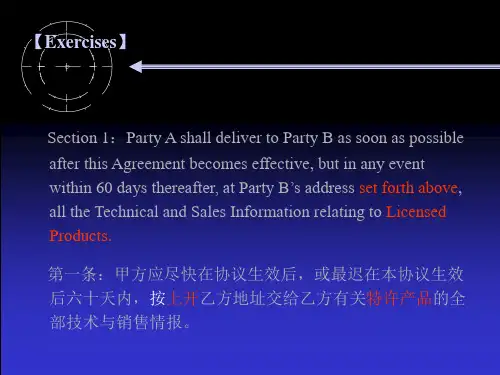
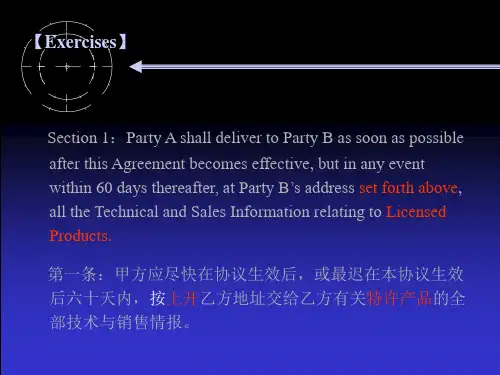

商务英语中的隐喻翻译及语篇连贯Metaphorical Translation in Business English and Coherence of DiscourseBusiness English is an important tool for communication in industrial and commercial fields. Therefore, metaphor translation is an essential part in business English for it conveys not only the information, but also the meanings behind the words. In addition, discourse cohesion should also be taken into consideration when translating a metaphor. Hereunder is the step-by-step guideline for metaphor translation in business English with discourse coherence.First of all, it is important to understand the source language. To make sure the target language is accurate, we need to comprehend the context in source language. We need to analyze the source language in detail, paying attention to the connotation and denotation of the words and phrases. By doing so, we can get a clear view on what the original speaker want to say and then we may begin our work of translation.Secondly, we need to decide which translation technique to use. As for metaphor translation, sometimes literal translation or dynamic equivalence can be used. Literal translation is sensible when the metaphor is universally accepted across different languages and cultures, such as the“elephant in the room”. However, other times cultural adaptation is needed. When the metaphor does not exist in target language and culture, dynamic equivalence would be a better choice.Thirdly, it is crucial to keep the discourse cohesion. Whenthe target language is well understood and track of the whole context is kept, maintain the coherence of discourse becomes relatively easy. If there is the metaphor used in onesentence in source language, we should focus more on the cohesion between this sentence and original context when translating.Lastly, there are edits and proofreads. After the translation, editing and proofreading are always needed in order to make sure everything fits properly. Pay attention to grammar, sentence structure and register, etc. ensure that the translation is of high quality and accurate.To conclude, metaphor translation in business English is an important skill to master. It consists of analysis of source language, selection of translation techniques, maintaining of discourse coherence and editing and proofreading. All these steps need to be done in order to finish a successful translation.。

商务英语段落翻译第一篇:商务英语段落翻译1.There is no alternative but to blend together different kinds of information.First, take whatever evidence econometrics can yield about the way the forces driving FDI——size of host-country market, expected growth, input costs, geography and natural resources, and the policy framework——have worked in the past.别无他法,我们只能将各种不同种类的信息联系起来进行分析。
首先,采取任何经济计量学中产生的可以驱动FDI的要素,包括东道国市场规模、预期增长、投入成本、地理优势和自然资源、政策构架已经在过去起作用了2.Look at Beyond Petroleum.It says it is an energy problem solver.Yet not much green has come out of its entrails.Each country has abiding cultural icons, its sacred cows that make global corporate communications quite challenge.What is culturally and politically correct in one country may not be so in another.看BP公司。
它宣称自己是能源问题解决者。
尽管其并没有太多绿色环保的产品从其中流露出来。
每个国家都有其长久的文化图腾,它们的文化图腾物使得全球化的企业的交流遇到了挑战。
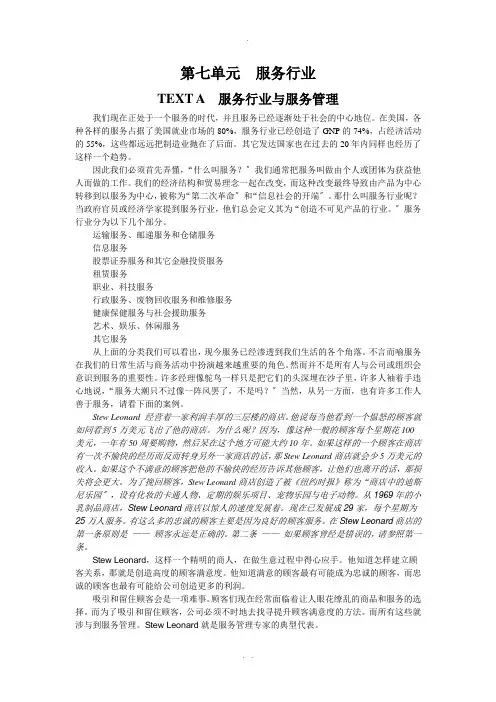
第七单元服务行业TEXT A 服务行业与服务管理我们现在正处于一个服务的时代,并且服务已经逐渐处于社会的中心地位。
在美国,各种各样的服务占据了美国就业市场的80%,服务行业已经创造了GNP的74%,占经济活动的55%,这些都远远把制造业抛在了后面。
其它发达国家也在过去的20年内同样也经历了这样一个趋势。
因此我们必须首先弄懂,“什么叫服务?〞我们通常把服务叫做由个人或团体为获益他人而做的工作。
我们的经济结构和贸易理念一起在改变,而这种改变最终导致由产品为中心转移到以服务为中心,被称为“第二次革命〞和“信息社会的开端〞。
那什么叫服务行业呢?当政府官员或经济学家提到服务行业,他们总会定义其为“创造不可见产品的行业。
〞服务行业分为以下几个部分。
运输服务、邮递服务和仓储服务信息服务股票证券服务和其它金融投资服务租赁服务职业、科技服务行政服务、废物回收服务和维修服务健康保健服务与社会援助服务艺术、娱乐、休闲服务其它服务从上面的分类我们可以看出,现今服务已经渗透到我们生活的各个角落。
不言而喻服务在我们的日常生活与商务活动中扮演越来越重要的角色。
然而并不是所有人与公司或组织会意识到服务的重要性。
许多经理像鸵鸟一样只是把它们的头深埋在沙子里,许多人袖着手违心地说,“服务大潮只不过像一阵风罢了,不是吗?〞当然,从另一方面,也有许多工作人善于服务,请看下面的案例。
Stew Leonard 经营着一家利润丰厚的三层楼的商店。
他说每当他看到一个愠怒的顾客就如同看到5万美元飞出了他的商店。
为什么呢?因为,像这种一般的顾客每个星期花100美元,一年有50周要购物,然后呆在这个地方可能大约10年。
如果这样的一个顾客在商店有一次不愉快的经历而反而转身另外一家商店的话,那Stew Leonard商店就会少5万美元的收入。
如果这个不满意的顾客把他的不愉快的经历告诉其他顾客,让他们也离开的话,那损失将会更大。
为了挽回顾客,Stew Leonard商店创造了被《纽约时报》称为“商店中的迪斯尼乐园〞,设有化妆的卡通人物、定期的娱乐项目、宠物乐园与电子动物。

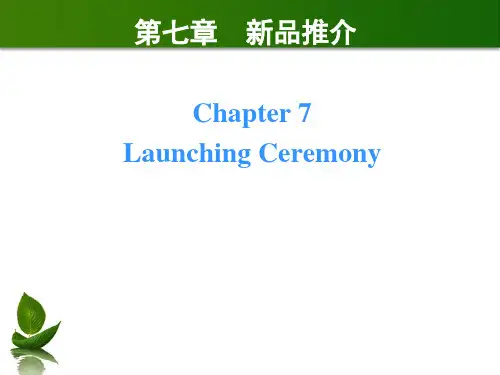
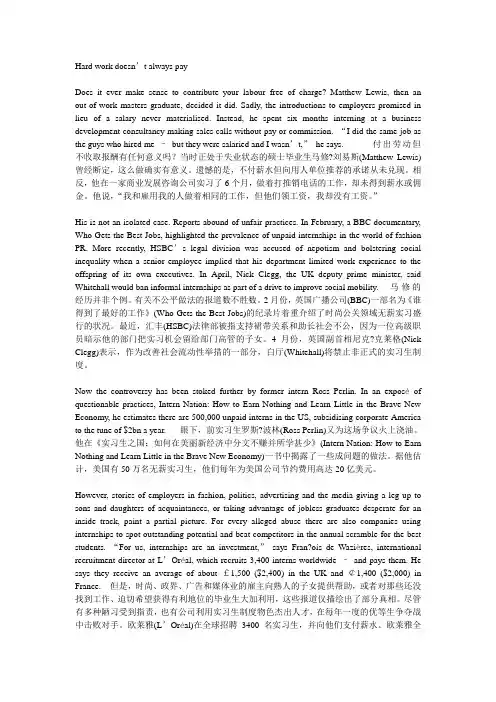
Hard work doesn’t always payDoes it ever make sense to contribute your labour free of charge? Matthew Lewis, then an out-of-work masters graduate, decided it did. Sadly, the introductions to employers promised in lieu of a salary never materialised. Instead, he spent six months interning at a business development consultancy making sales calls without pay or commission. “I did the same job as the guys who hired me –but they were salaried and I wasn’t,”he says. 付出劳动但不收取报酬有任何意义吗?当时正处于失业状态的硕士毕业生马修?刘易斯(Matthew Lewis)曾经断定,这么做确实有意义。
遗憾的是,不付薪水但向用人单位推荐的承诺从未兑现。
相反,他在一家商业发展咨询公司实习了6个月,做着打推销电话的工作,却未得到薪水或佣金。
他说,“我和雇用我的人做着相同的工作,但他们领工资,我却没有工资。
”His is not an isolated case. Reports abound of unfair practices. In February, a BBC documentary, Who Gets the Best Jobs, highlighted the prevalence of unpaid internships in the world of fashion PR. More recently, HSBC’s legal division was accused of nepotism and bolstering social inequality when a senior employee implied that his department limited work experience to the offspring of its own executives. In April, Nick Clegg, the UK deputy prime minister, said Whitehall would ban informal internships as part of a drive to improve social mobility. 马修的经历并非个例。

高级商务英语阅读课文译文第1 课主课文译文新长征“中国制造”这个标记很久以前就不新鲜了,它贴在鞋子上、玩具上、服装上,以及为跨国公司制造的其他商品上,世界各地到处可见。
现在真正新鲜的是以中国品牌出售的中国制造的商品。
目前中国只有为数不多的几家公司拥有足够的财力和管理知识来打造国际名牌;其余的绝大多数公司还在为在国内获得知名度而努力奋斗着。
但是正在海外市场上试水的各大先锋公司,很有可能把事情做大。
一些人认为,在创业精神饱满的本地管理层的协助下,或者在一些想在其产品系列里添加新产品的外国公司的协助下,中国商品在极具竞争力的价格的基础上,若把卖点放在产品质量和异国情调上,那末10 年之内,中国品牌将一个一个地走向全球。
总部在香港的广告公司中国精信(Grey China)的执行董事陈一木丹(Viveca Chan)说:“如果世界上只有一个国家具备创立全球品牌的潜力,那么这个国家就是中国。
”短期之内,中国商品最有希望打入国际市场的当属中草药和特色食品,当然也包括那些体现中国浪漫并具有异国情调的产品,例如化妆品、时装和音乐作品。
中国总部设在上海的泰勒·娜尔森·索福瑞(Taylor Nelson Sofres)市场调研公司的中国区总经理Kevin Tan 说:“与中国相联系的神秘色彩还有许多。
化妆品是种靠形象推销的产品,假如你要做化妆品,你会一下子就发现,中国化妆品来头不小。
”努力走向世界的中国品牌还有一些领导时尚潮头的饮料和啤酒品牌,也包括家用电器等具有品牌潜力的产品,它们都能以竞争性的价格提供高品质的产品。
这些中国品牌中的一部分,最终将会通过合资、兼并和收购的途径走向国际市场。
而对于合资双方中的外国投资者来说,这些品牌则将成为他们更快地进入中国消费市场和销售渠道的载体,同时这些中国品牌也能进一步充实国外投资者在国际市场上已经确立的优质品牌的阵营。
整个20 世纪90 年代,“中国品牌”这个概念一直在发育着,而目前在国内受到的重视更大了。
大学商务英语教材译文商务英语是一门与商业领域紧密相关的英语学科,它旨在培养学生在商业环境中使用英语的能力。
下面是一段大学商务英语教材的译文,帮助学生更好地理解和掌握商务英语知识。
Lesson 1: Introduction to Business English第一课:商务英语简介Business English is a specialized area of English language learning that focuses on the language skills needed in various business situations. Intoday's globalized world, the ability to communicate effectively in English is essential for success in the business field. This lesson will provide an overview of the objectives and content covered in this course.Lesson 2: Business Communication第二课:商务沟通Effective communication is crucial in the business world. This lessonwill introduce different types of business communication, such as emails, memos, and reports. Students will learn how to write clear and concise messages, and develop the essential skills needed for effective business communication.Lesson 3: Meetings and Presentations第三课:会议与演示In the business environment, meetings and presentations play a significant role in decision-making and information sharing. This lesson will teach students the language and skills necessary to participate in meetings, conduct presentations, and engage in discussions. Students will also learn how to use visual aids and deliver persuasive presentations.Lesson 4: Negotiations and Contracts第四课:谈判与合同Negotiations are an integral part of conducting business. This lesson will focus on the language and strategies used in negotiations, including bargaining, reaching agreements, and handling conflicts. Additionally, students will study contract terms and conditions, and understand the legal implications of business agreements.Lesson 5: International Business第五课:国际商务In today's global market, understanding international business practices is essential for success. This lesson will explore topics such as international trade, cultural diversity, and business etiquette in different countries. Students will also learn how to communicate and negotiate effectively with international partners.Lesson 6: Marketing and Advertising第六课:市场营销与广告Marketing and advertising are vital components of any business. This lesson will introduce students to marketing strategies, market research,consumer behavior, and advertising techniques. Additionally, students will learn how to create marketing plans and develop effective advertising campaigns.Lesson 7: Business Ethics and Corporate Social Responsibility第七课:商业道德与企业社会责任Ethics and social responsibility are increasingly important in today's business world. This lesson will discuss ethical principles, corporate social responsibility initiatives, and the role of business in society. Students will examine case studies and engage in discussions on ethical decision-making.Lesson 8: Cross-cultural Communication第八课:跨文化交流In a global business environment, effective cross-cultural communication is vital. This lesson will explore cultural differences, communication styles, and strategies for bridging cultural gaps. Students will develop cultural sensitivity and enhance their ability to work in multicultural teams.Lesson 9: Job Interviews and Resume Writing第九课:求职面试与简历撰写Preparing for job interviews and writing effective resumes are crucial skills for successful career development. This lesson will provide tips and techniques for job interviews, including how to answer common interview questions and make a positive impression. Students will also learn how to write professional resumes and cover letters.Lesson 10: Business Case Studies第十课:商业案例分析Business case studies provide practical insights into real-life business scenarios. This lesson will examine various case studies and encourage students to analyze and solve business problems. Students will apply their knowledge of business English in simulated business situations.Conclusion结语This university-level business English textbook provides students with comprehensive knowledge and practical skills necessary to excel in the business field. By mastering the language and strategies taught in this course, students will be well-equipped to communicate effectively and succeed in their future careers.。
大一新生课上演讲商务英语主题英文中文商务英语主题: 如何在商务环境中成功英文演讲稿:Ladies and gentlemen,Good morning/afternoon! Today, I would like to talk about a topic that is crucial for success in the business world - how to succeed in a business environment.In today's fast-paced, globalized world, it is essential to equip ourselves with the necessary skills and knowledge to thrive in a business setting. The following are some key points to consider:Firstly, effective communication is paramount. Proficient English language skills, both written and spoken, are crucial for clear and concise business communication. In addition to language proficiency, it is essential to communicate confidently and professionally, whether it is face-to-face, over the phone, or through email. Active listening is also a crucial aspect of effective communication, as it allows us to understand others' viewpoints and respond accordingly.Secondly, developing strong interpersonal skills is vital for building successful business relationships. Interacting with colleagues, clients, and partners with respect, empathy, and understanding fosters trust and cooperation, which are the foundations of successful collaborations. Additionally, networkingplays a significant role in business success. Attending industry events, joining professional organizations, and connecting with professionals through social media platforms can open doors to new opportunities.Next, a solid understanding of the global business culture is crucial. Being aware of cultural differences and adapting our behavior accordingly is a key component of successful business interactions. Knowing how to navigate through different business practices, etiquette, and negotiation styles increases the chances of fruitful outcomes in international business endeavors.Moreover, staying up-to-date with current business trends and industry developments is essential for success. This includes being aware of technological advancements, economic shifts, and market trends that can significantly impact business operations. Continuous learning through reading business publications, attending seminars, and engaging with industry leaders enables us to adapt and seize opportunities in an ever-changing business landscape.Lastly, maintaining a strong work ethic and being adaptable is essential. Demonstrating dedication, perseverance, and a willingness to learn and improve are qualities valued in the business world. Adapting to new challenges and opportunities with a growth mindset allows us to thrive in a dynamic business environment.In conclusion, succeeding in a business environment requires effective communication, strong interpersonal skills, culturalawareness, staying informed, and maintaining a strong work ethic. By continuously honing these skills and keeping the above pointsin mind, we can enhance our chances of achieving success in the business world. Thank you.中文翻译:女士们先生们,大家早上/下午好!今天,我想谈论一个在商业世界中至关重要的主题 - 如何在商业环境中成功。
Unit 7 Work EnvironmentReading A改善工作环境可提高雇员的积极性如今,当雇员们谈及如何评价对工作的满意度时,他们会把工资报酬当作考虑的第一因素,对此人们并不感到奇怪。
但令人意外的是,他们将工作环境的舒适度及美观度看作和排在第二位的津贴几乎同等重要。
随着越来越多的人花更多的时间在办公场所,工作环境也变得日益重要。
去年,美国室内设计协会在全国范围内委托进行了一项名为“通过设计招募与保留合格员工”的调查。
该调查显示:*对工作环境满意的员工对工作表示满意的几率比其他人群高出31%;*办公场所的环境可以影响41%的雇员和求职者决定是否接受一份工作;*办公场所的环境质量会影响51%的雇员决定是否离开一间公司;*更令人吃惊的是,73%的雇员对其目前办公场所的环境表示不满意。
为了留住那些有价值的员工或吸引那些有潜力的求职者,雇主们有必要对办公环境做一些细小但又有意义的改动。
“在这个激烈的市场竞争中,办公场所的外观需要得到更多的关注,”专营家用及办公壁画的环境制图公司主席托德·伊姆和特解释道,“研究表明那些关心雇员及工作环境的雇主拥有更多富于积极性和成效性的员工。
”米尼苏达州大学工业与组织心理学系的丹尼斯·瓦恩斯博士说道,“我们都知道在工作场所里,积极性及生产率之间存在着密切的关联。
那些被激励的雇员更加细心、可靠,从而,工作效率更高。
”位于肯塔基州乔治镇的丰田制造厂最近在他们整个生产车间、实验室和会议室安装了44幅环境制图公司制作的壁画。
按照安全主管卡伦·韦尔斯的说法,“这些壁画可以将室外的风景带进来,使工作环境变成一个对员工们来说更积极、更令人振奋的地方。
当他们抬头往墙上看时,他们可以欣赏到令人心旷神怡的风景,而不是枯燥的墙壁。
我们甚至让员工们来挑选这些壁画。
”环境制图公司的壁画给人们带来了自然灵感,表现了纯正的风水元素,售价在100美元左右。
主要的设计包括祥和的风景、东方园林、夏威夷落日、云层、晨曦中的森林、树林间的湖泊及野花盛开的沙漠,还有该公司最新的版本——拱顶灯塔。